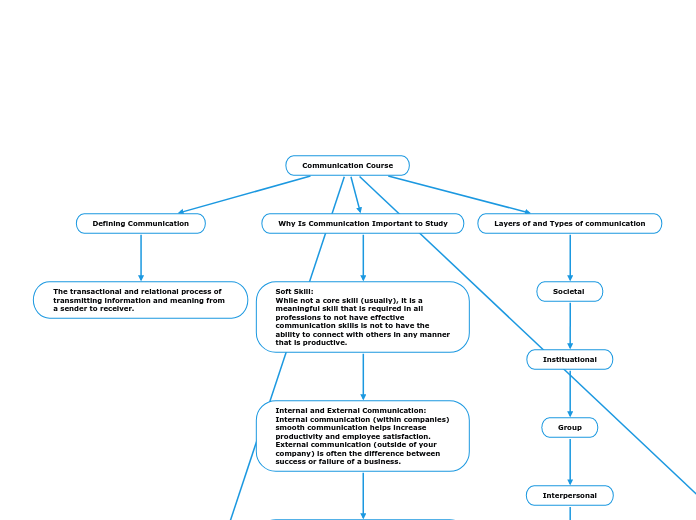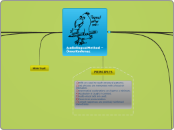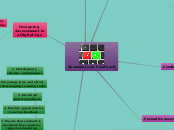Module 2: Communication Principles
culture map
Scheduling
Disagreeing
Trusting
Deciding
Leading
Persuading
Evaluating
Communicating
Intercultural Communication
Make the effort but accept mistakes.
Don't let setbacks or mistakes stop you from continuing to do the best you can.
Avoid idioms
Idioms like "Kick the bucket" might make sense to native speakers but second languages will not understand.
Make the effort to speak clearly
Slowing down your rate of speech a little is okay as well but try not to overdo it.
Do some research
Trying to accommodate another culture's norms can have a positive effect.
Ask questions and Repeat what was said
Active listening
Avoiding Nosie
Be Proactive
Keep them updated.
Know your bosses preferred communication.
Make your communication Economical
Active Listening and Careful Reading
Pause before replying. They claim you avoid the risk of interrupting. show careful consideration for they words. You hear their words better.
Paraphrase their words.
Nurture Contextual Awareness Through Perception Checking
Perception check.
describe the behaviour.
Give two possible reasons.
Ask for feedback.
Make your communication purposeful
3 part frame work.
Bottom line
1.
2.
3.
firstly, details.
secondly, details,
thirdly, details,
final statement
Types of noise
Environmental Interference
That person's culture, religion, personality, class, education will affect how they perceive the world around them, including how they encode and decode communication.
Channel Interference
The channel itself breakdown. The channel itself is the source of the problem.
Choosing the appropriate channel for the context of communication is crucial to avoid channel interference.
Phyiscal Interference
Physical interference is the result of lights, sounds, movements, etc. present in the physical environment that might distract the sender/receiver.
Physiological Interference
When pain or disability in the body or bodies of the sender and or receiver interferes a message.
People with disabilities, particularly, visual and auditory ones, special consideration is required to address physiological interference.
Technical Interference
Any sort of technical problem. video lagging, phone cuts in and out, etc.
Semantic Interference
Communication requires the shared understanding of what certain symbols mean.
Common examples are people speaking different languages, slang, and professional jargon.
Emotional Interference
When our emotions cause us to either send or receive messages' in a way that is inaccurate o that distorts the idea.
Overload Interference
Too much information too quickly can cause some of that information to be missed. "Overload" of information means that more information is coming n than can be processed.
Key terms
Field of Experience
The cultural, linguistic, social, cultural economic, and professional context that inform the worldview of any given sender or receiver.
Channel
This form is the media that the sender uses to send their message. Some common channels are speaking face-to-face, phone call, text, email, letter. Different context means different channels are more or less appropriate.
Noise
Anything that disrupts or distorts a message.
Feedback
when a receiver responds to a message by sending communication back to the person that sent it to them.
This could be in the form of facial expressions, gestures, questions for clarification, or a response.
Feedback also means the roles are reversed, and a new cycle of communication commences.
Decode
The act of taking symbols and interpreting them to understand an idea. Frequently this is in the form of listening or reading.
Encode
The act of taking an idea and putting it into symbols that can be sent. Frequently this is in the form of spoken or written words. Although, not limited to speech and written words it can be other things such as gestures, dance moves, etc.
Reciever
The individual or individuals who a message is sent to. They interpret the message sent to them.
Sender
The individual who takes their idea, coverts it into symbols, and sends it to a receiver.
Communication Course
6 Keys of powerful communication
Listening
Clarity
Empathy
Open-mindedness
Authenticity
Assertiveness
Subtopic
Verbal and Non-verbal communication
Microexpressions
Contempt
Disgust
Sadness
Anger
Fear
Suprise
Happiness
Microexpressions:
Nonverbal Communication:
How you look, your gestures, facial expression, etc, and how you sound, tone, pacing, pauses, etc.
How do they work together
1. Repeating:
When a nonverbal behavior reinforces a verbal message.
2. Substituting:
When we use a gesture or other nonverbal cue in place of a word.
3. Turn-Taking:
Relying on nonverbal communication to signal turn-taking.
4. Complementing:
Enhancing a verbal message with nonverbal communication.
5. Emphasizing:
To accentuate a verbal message, especially in a speech, presentation, meeting, or pitch.
6. Contradicting:
This occurs when your nonverbals contradict your spoken words.
This is call nonverbal "leakage"
Illustrators:
We use automatic nonverbal gestures and cues subconsciously to illuminate our words.
Emblems:
The nonverbal cues that have a universal meaning within a specific culture.
Layers of and Types of communication
Societal
Instituational
Group
Interpersonal
Intrapersonal
Why Is Communication Important to Study
Soft Skill:
While not a core skill (usually), it is a meaningful skill that is required in all professions to not have effective communication skills is not to have the ability to connect with others in any manner that is productive.
Internal and External Communication:
Internal communication (within companies) smooth communication helps increase productivity and employee satisfaction.
External communication (outside of your company) is often the difference between success or failure of a business.
Transferable:
Unlike core skills that are usually not transferable to another specialty. Communication skills are extremely transferable and are needed in every profession to some degree or another.
Defining Communication
The transactional and relational process of transmitting information and meaning from a sender to receiver.









